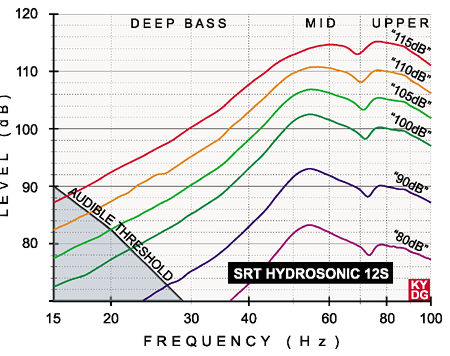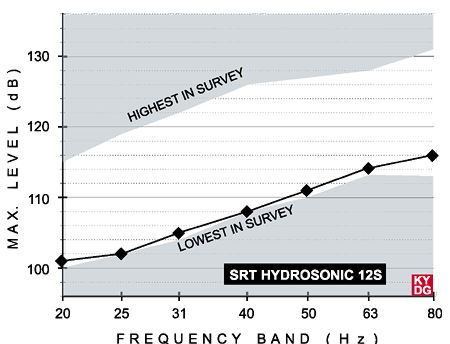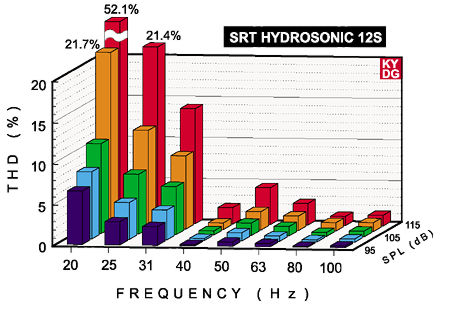Way Down Deep II SRT Hydrosonic HS-12S
To the list of conventional subwoofer enclosure materials—plywood, medium-density fiberboard (MDF), countertop synthetics such as Corian, and the occasional concrete pouring form—Sound Related Technologies (SRT) weighs in with something novel: tap water. SRT says its HydroSonic HS-12S reaps a solid advantage in the deep bass and even infrasonic range by dint of an internal partition formed principally of a vinyl bladder filled with 3.5 gallons of water, and resting on a piece of perforated plywood of the same 3/4-inch thickness used throughout the rest of the enclosure. The idea is that air-pressure fluctuations in the acoustic chamber will induce vibrations in the water that will propagate throughout the enclosure, through the four caster feet, into the floor, and thence to the listener, who will perceive the extended-range content at least partially as vibro-tactile rather than as purely auditory information.
SRT's talk of "hydro-acoustic coupling" and vibration conduction is almost guaranteed to elicit paroxysms of eyebrow arching among the company's competitors, the engineering community, and audio consumers. The conventional wisdom is that, absent an effective vibration-abatement plan (which typically begins with thick, stoutly braced, well-damped cabinet walls), enclosure panels end up as lo-fi, low-output drivers spewing incoherent facsimiles of the main signal. You could think of buying a subwoofer fashioned of deliberately "chatty" enclosure surfaces as analogous to buying a ticket to a concert featuring Pavarotti singing with half a dozen members of the audience, all tone-deaf.
Yet while SRT's competitors have been wagging their fingers, the trickle of HydroSonic subs into commercial cinemas has swelled into something like a mini-flood. It's enough to get the prospective purchaser wondering: Is it possible this low-profile Virginia company has turned the planet's most plentiful substance into some sort of subwoofer secret sauce?
The model tested here is the middle one in SRT's three-model rollout for the home theater market. The aqueous angle aside, the HS-12S is a conventional design using a single 12-inch driver in a bandpass arrangement.
Measurements
Frequency response at 80dB (Fig.13): 20–100Hz, +/-13dB; 35–100Hz, +/-7dB; –10dB at 37Hz. Response showed a pronounced midbass emphasis around 55Hz and fell off rapidly (at approximately 20dB/octave) below about 50Hz, thus showing little or no usable response throughout the deep-bass range.

Fig.13: Frequency Response vs. Output
Frequency response at higher levels (Fig.13): Basic response shape remained consistently weak throughout the 20–40Hz deep-bass range at all playback levels. The bulge at 55Hz progressively flattened with increasing drive level.
Dynamic range: Apart from its limited output at low frequencies, the SRT exhibits little power compression below 40Hz, with each increase in input level producing a corresponding increase in output (Fig.14). On Linkwitz shaped tone-burst tests (Fig.15) the HS-12S's maximum output before distortion landed within 1–2dB of the bottom performer among the 12 subwoofers tested in the survey, suggesting that its sagging response in the bottom octave will be difficult to prop up via external equalization.

Fig.14: Power Compression

Fig.15: Shaped Tone-burst Peak Output
Total harmonic distortion (Fig.16): Distortion was low at all playback levels throughout the HS-12S's 50Hz-and-up operating range. THD results below 50Hz should be viewed in light of the test sample's inability to muster what is conventionally termed "usable" output in that range. Some Coke-bottle–like whistling was evident when playing test tones at and around 125Hz; this is unlikely to be an issue in most installations, where the sub will be lowpass-filtered at some point below 100Hz. A fuzzy, fricative-type ffff sound accompanied 50Hz test tones at levels of 105dB and above; at 110 and 115dB levels, the same distortion was heard on 40 and 63Hz tones as well.

Fig.16: Total Harmonic Distortion vs. Frequency & Level
Sensitivity: 87dB/2.83V/m at 40Hz.
Impedance: Nominally 8ohms (8.6ohms minimum). Together with its sensitivity, the HS-12S represents a relatively nontaxing load for any modern power amplifier rated to deliver >100Wpc into 8ohms.
Listening
That final, ground-shaking clomp about 10 seconds before the end of "Jurassic Lunch" (Figs.A1 and A5) normally signals the T. rex's departure. In this case, it wasn't the dino that had vanished, but the bass itself. In failing to register anything more substantial than a faint, fleeting flutter of high-frequency noise, the HS-12S left me in a quandary: Had the murderous proto-lizard left the premises, or was it still lurking? Was I supposed to be relieved, or still terrified? No clue, nada. I ran a few quick measurements, called the manufacturer, verified that the response was within spec, and resumed my listening tests.
 A quick study of the spectrograms (waterfall plots) of the depth-charge detonations taken from the U-571 DVD and those generated by the HS-12S (Figs.B1 and B5) foretell the subjective findings. The underwater blasts were rendered as restrained thwocks "more suggestive of kids down the street playing with tiny popguns than a submarine being crushed by depth charges," according to my listening notes.
A quick study of the spectrograms (waterfall plots) of the depth-charge detonations taken from the U-571 DVD and those generated by the HS-12S (Figs.B1 and B5) foretell the subjective findings. The underwater blasts were rendered as restrained thwocks "more suggestive of kids down the street playing with tiny popguns than a submarine being crushed by depth charges," according to my listening notes.
Filmmakers shape our thinking with the picture and our feeling with the soundtrack. No matter how skillfully edited the narrative or rich the cinematography, muting the sound system will almost always drain a story of its power to elicit an emotional response from the audience. A form of muting is what occurred about 35 minutes into Black Hawk Down, where the deep, sustained, 18Hz rumble that anchors the soldiers' scramble across the tarmac to the choppers was decidedly AWOL (Figs.C1 and C5). Even the 32Hz component—one vertical red stripe to the right in the waterfall plot—was close to a no-show. This prevented the SRT unit from creating that "Oh, no," slightly sick-in-the-stomach sense that, as the choppers spin up, the lives of a few dozen sympathetic American boys are about to spin out of control.
With the right subwoofer and the Kunzel/Cincinnati recording of the 1812 Overture cued to that final, crushing cannon fusillade, your pant legs flap and you could swear you smell gunpowder. With the HydroSonic unit, the blasts came across not as a demonstration of 19th- century shock and awe, but more "like a schoolboy pelting a VCR shipping carton with wiffle balls," as my session notes put it. There was certainly no aural evidence that the famous recording, originally Telarc CD-80041 and recently redone for DVD-A, was the kind of sure-fire demo track audio salesmen have relied on for decades to get the most impassive customer bestirred enough to haul out his wallet.
Even more disappointing was Béla Fleck's "Flight of the Cosmic Hippo," where the fretless bass guitar—in this case it'd be fairer to call it the feckless bass guitar—lacked sufficient body to conjure a hippopotamus slip-sliding through space. It did manage to hint at something almost as comical, but it was a little less smooth and way less imposing than that big, wallowing denizen of river bottoms—something more along the lines of a dachshund or a Mexican Hairless.
On all of the foregoing tracks, bass realism actually improved when I disconnected the HS-12S and simply ran the main left/right monitors full-range. Patching the sub back in turned a home theater experience into something that felt more like watching TV.
Although it's the laggard performer among the 12 in the survey, the SRT managed to get through a handful of music selections with some portion of its dignity intact. Success on such tracks was almost certainly traceable to the lack of significant recorded content below 40Hz. (The bass-drum whacks that propel rock music generally have their energy concentrated in the 50–80Hz range, where the SRT's response is relatively strong.)
With the objective and subjective performances so flaccid on selections calling for a stiff response, we're left with SRT's contention that "hydro-acoustic coupling" adds a feelable deep-bass dimension missed by conventional subs. I have a long-standing interest in the use of vibration to convey infrasonic information—a few years ago, I spent a summer semester at Stanford designing and conducting experiments on the human ability to detect timing misalignment between the auditory and vibro-tactile senses in the deep bass. However, at no point in several months of testing was there any evidence that the SRT HS-12S added any special vibro-tactile enhancement, infrasonic or otherwise. This finding occurred no matter where I played the HS-12S: outdoors on grass, in the living room on tongue-and-groove oak flooring over standard wood joists, or in the office on carpet over concrete slab.
After I wrapped up the conventional tests, I pulled out a precision accelerometer (Brüel & Kjær 4501), fitted it to the 2260 Investigator sound-level meter, fed its output to the TEF's input, and reran my frequency sweeps, looking for signs of higher-than-usual vibration in the floor immediately below the HT-12S. I didn't find any. The reader is free to view that result in either of two ways: disappointedly, because the advertised "hydro-acoustic coupling" doesn't occur, at least to any readily perceptible degree; or thankfully, for the same reason.
If there's a larger conclusion here, it's not that, as an acoustic enclosure material, a sack of water is an inherently inferior substitute for, say, a sheet of MDF. Nor is it that "hydro-acoustic coupling" is incapable of playing a useful role in some future high-performance subwoofer by SRT—or anyone else, for that matter. It's that getting a subwoofer to play believable bass starts with nailing the fundamentals: reasonably flat response to well below 30Hz, a response shape that stays intact at all playback levels, low power compression, high maximum level before distortion throughout the sub's operating range, and adequately low distortion at all playback levels.
Specifications
SRT HydroSonic HS-12S non-magnetically shielded, passive subwoofer in bandpass (ported) cabinet of 7-ply, 3/4" thick Baltic birch plywood
Driver: 12" pulp cone with 2.5" voice coil, 1.75" peak–peak linear excursion
Frequency response: 35–125Hz, +/-5dB
Inputs: gold-plated 5-way binding posts
Power handling: 250W continuous, 600W peaks
Finish: black industrial paint
Dimensions: 27.25" x 21.5" x 19" (WxHxD)
Weight: 165 lbs
Price: $1450
Sound Related Technologies, Inc.
(757) 377-2450
www.soundrelatedtech.com
- Log in or register to post comments






























































